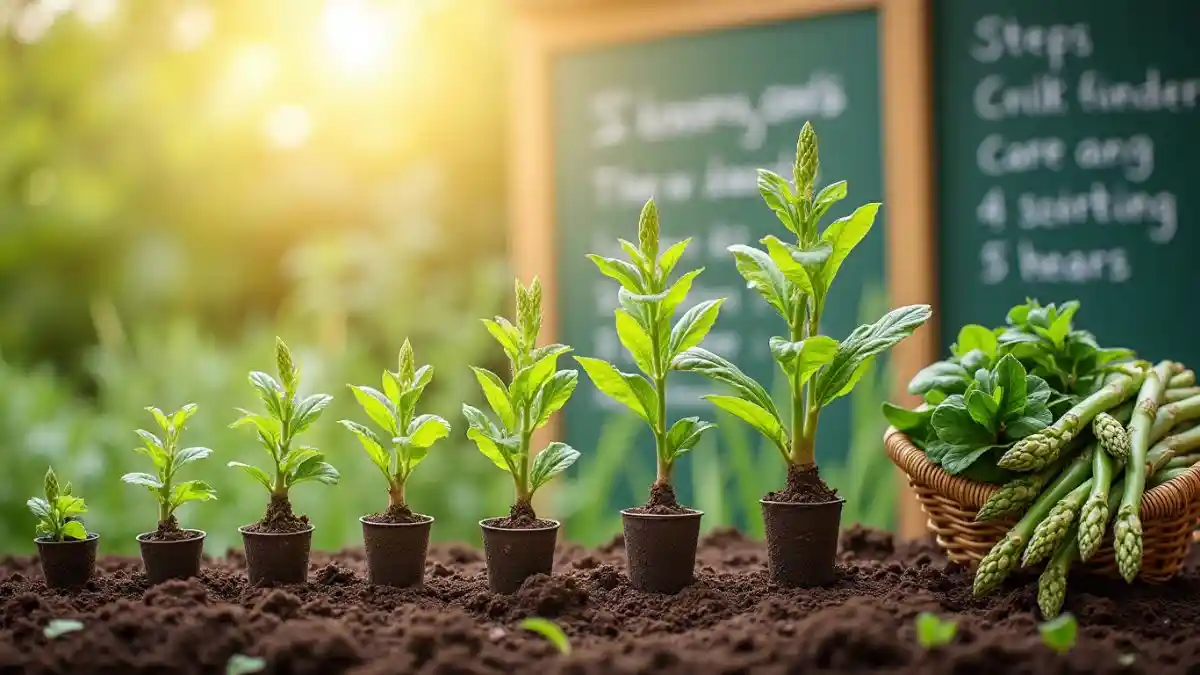Imagine stepping into your backyard and harvesting fresh, homegrown asparagus straight from your garden. Sounds rewarding, right? Growing asparagus from seeds is easier than you think, and it’s a journey worth taking.
Asparagus is a perennial vegetable that can produce for 15–20 years, making it a fantastic addition to any garden. While many gardeners opt for asparagus crowns for a quicker harvest, growing asparagus from seeds offers unique advantages. It’s cost-effective, allows you to choose from a wider variety of cultivars, and connects you to the entire lifecycle of this delicious vegetable.
In this guide, we’ll walk you through 7 easy steps to grow asparagus from seeds, helping you create a thriving, perennial garden. Whether you’re a beginner or an experienced gardener, these tips will set you up for success. Let’s dig in!
Table of Contents
Why Grow Asparagus from Seeds?
Growing asparagus from seeds might seem daunting, but it’s a rewarding process with several benefits:
- Cost-Effective: Seeds are cheaper than asparagus crowns, making them a budget-friendly option.
- Variety: You’ll have access to a wider range of cultivars, including unique colors like purple asparagus.
- Sustainability: Starting from seeds allows you to grow organic, chemical-free asparagus.
- Educational: Watching your asparagus grow from seed to harvest is a fulfilling experience.
For example, a packet of asparagus seeds costs around 3–5 and can yield dozens of plants, while asparagus crowns can cost 2–5 per plant. By growing asparagus from seeds, you can save money and enjoy a wider selection of varieties.
7 Easy Steps to Grow Asparagus from Seeds
Ready to grow your own asparagus? Adhere to these 7 steps to guarantee success:
1. Choose the Right Asparagus Variety

The first step in growing asparagus from seeds is selecting the right variety for your garden.
- Popular Varieties:
- Mary Washington: A classic, disease-resistant variety ideal for beginners.
- Purple Passion: Known for its sweet, tender spears and vibrant color.
- Jersey Knight: A high-yield variety that thrives in cooler climates.
- Considerations:
- Select a variety that fits your climate and soil conditions.
- Look for disease-resistant cultivars to reduce maintenance.
For example, if you live in a cooler region, ‘Mary Washington’ is an excellent choice, while ‘Purple Passion’ adds a unique touch to your garden.
2. Start Seeds Indoors
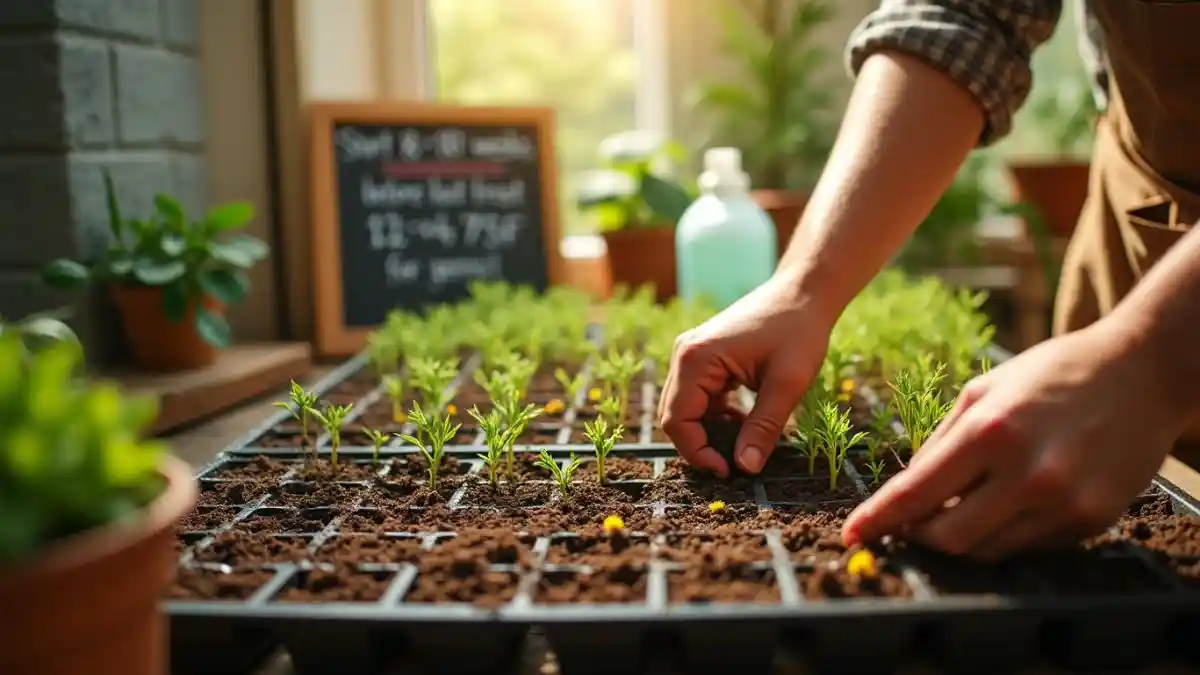
Asparagus seeds need a head start indoors before transplanting.
- When to Start: Begin 8–10 weeks before the last frost date in your area.
- How to Plant:
- Fill seed trays with well-draining soil.
- Sow seeds ¼ inch deep and maintain moist soil.
- Ensure 12–16 hours of light daily using grow lights or a sunny windowsill.
- Germination Tips:
- Immerse seeds in water for 24 hours before planting to accelerate germination.
- Maintain a temperature of 70–75°F for optimal growth.
For example, if your last frost date is in mid-April, start your seeds indoors in late January or early February.
3. Prepare the Garden Bed
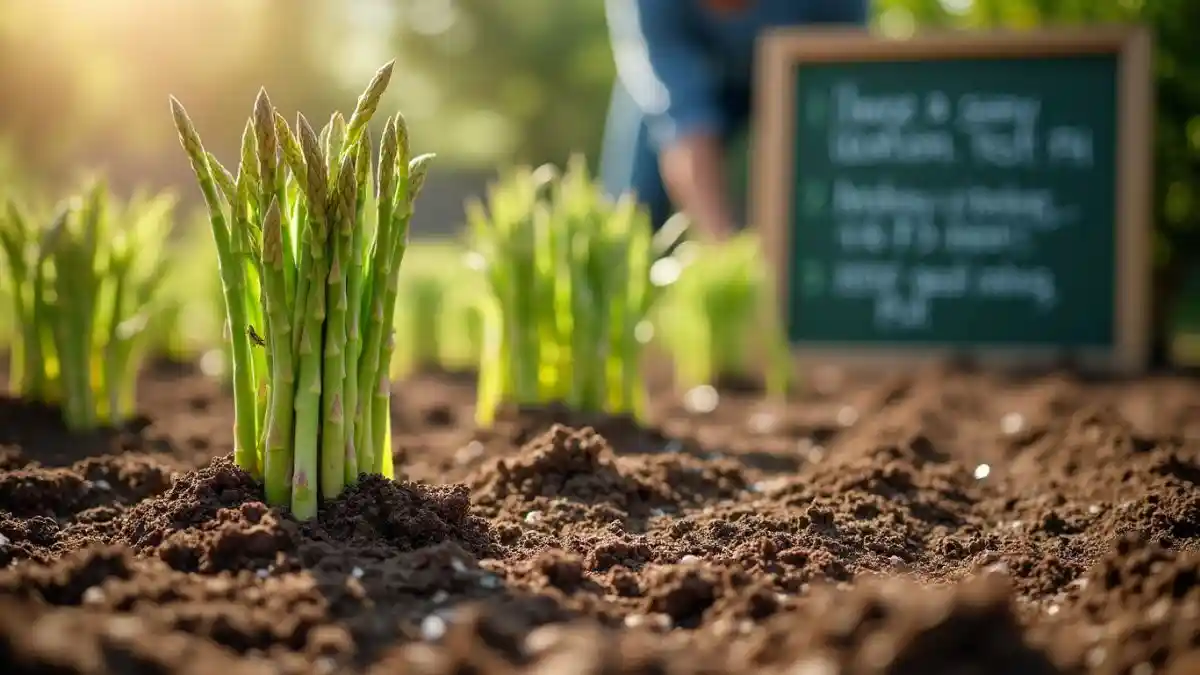
Asparagus thrives in well-prepared soil, so take the time to set up your garden bed properly.
- Location: Select a sunny spot with a minimum of 6–8 hours of sunlight daily.
- Soil Preparation:
- Test the soil pH (ideal range: 6.5–7.5).
- Amend the soil with compost or aged manure for nutrients.
- Make sure the soil drains well to avoid root rot.
- Spacing: Asparagus plants need room to grow, so plan for rows 3–4 feet apart.
For example, a 10-foot row can accommodate 6–8 asparagus plants, spaced 12–18 inches apart.
4. Transplant Seedlings Carefully
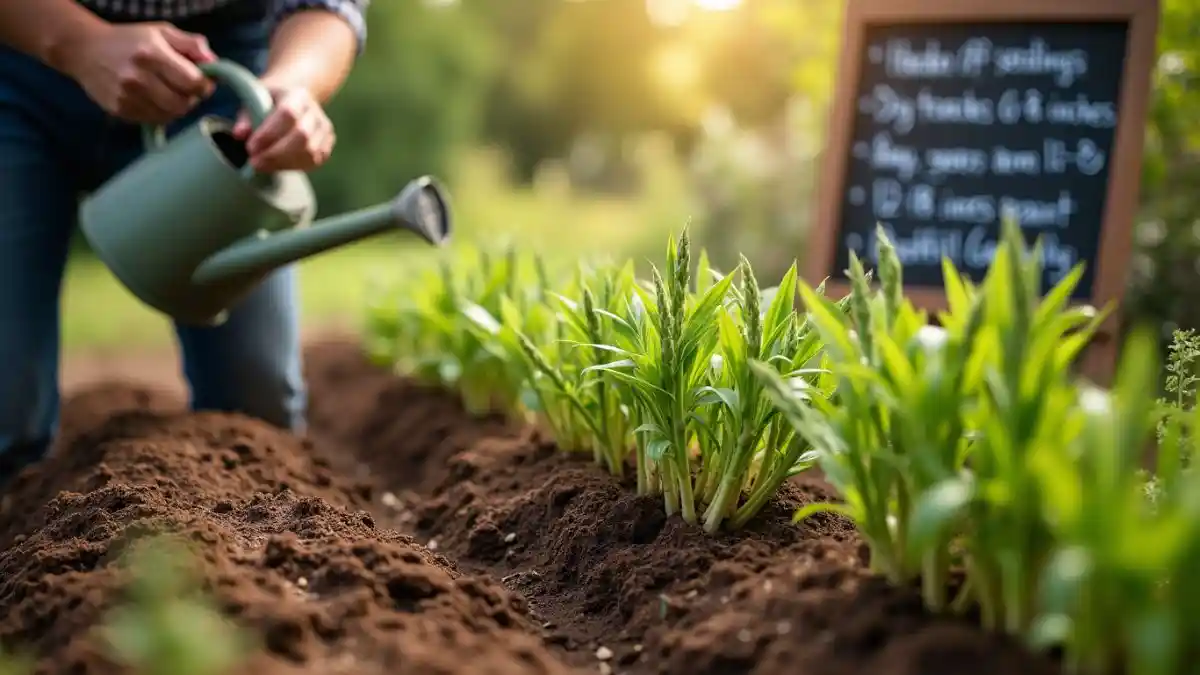
Once your seedlings are 6–8 inches tall and the danger of frost has passed, it’s time to transplant them outdoors.
- Hardening Off: Slowly acclimate seedlings to outdoor conditions over 7–10 days.
- Planting Depth: Dig trenches 6–8 inches deep and place seedlings in the center.
- Spacing: Space plants 12–18 inches apart in rows 3–4 feet apart.
- Backfilling: Cover the roots with 2 inches of soil initially, then fill in the trench as the plants grow.
For example, plant your seedlings in early spring, after the soil has warmed to at least 50°F.
5. Water and Mulch Regularly
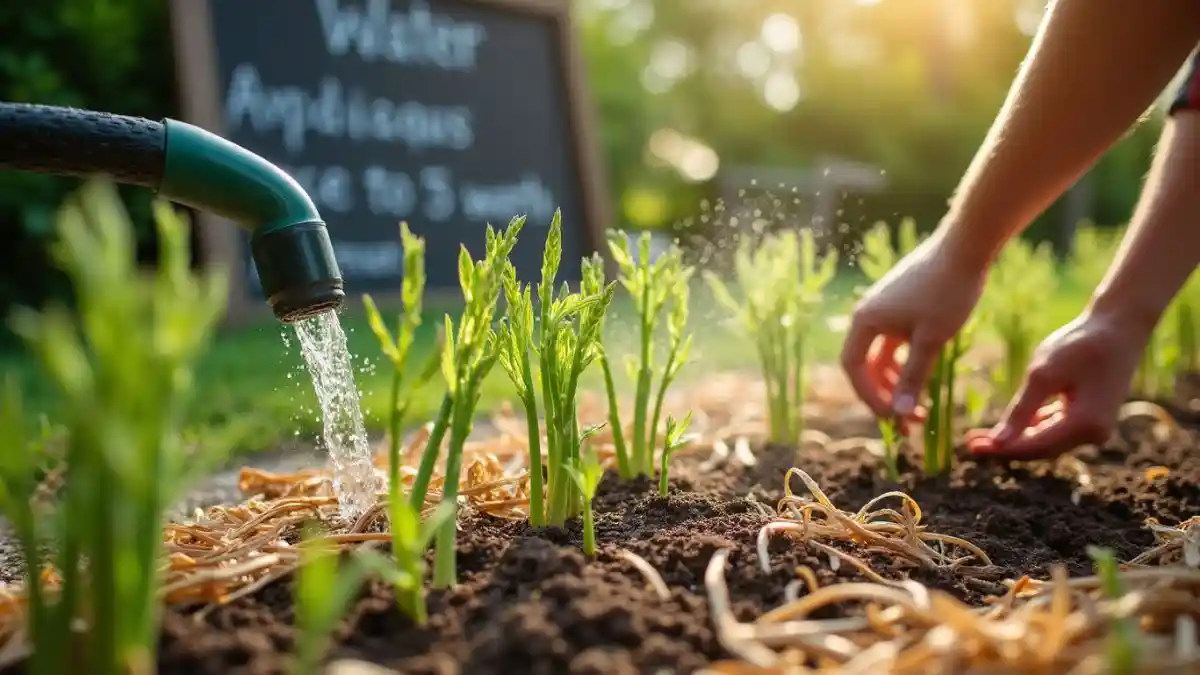
Asparagus needs consistent moisture, especially during the first few years.
- Watering: Water thoroughly once a week, keeping the soil moist but not waterlogged.
- Mulching: Apply a 2–3 inch layer of mulch (e.g., straw or wood chips) to retain moisture and suppress weeds.
- Avoid Overwatering: Asparagus prefers well-drained soil, so avoid soggy conditions.
For example, use a soaker hose to deliver water directly to the roots, minimizing evaporation.
6. Fertilize for Optimal Growth

Proper fertilization ensures healthy, productive asparagus plants.
- When to Fertilize: Apply a balanced fertilizer (10-10-10) in early spring and after harvesting.
- Organic Options: Use compost or aged manure to enrich the soil naturally.
- Avoid High Nitrogen: Too much nitrogen can promote fern growth at the expense of spears.
For example, side-dress your asparagus plants with compost in early spring to boost growth.
7. Be Patient and Wait for Harvest
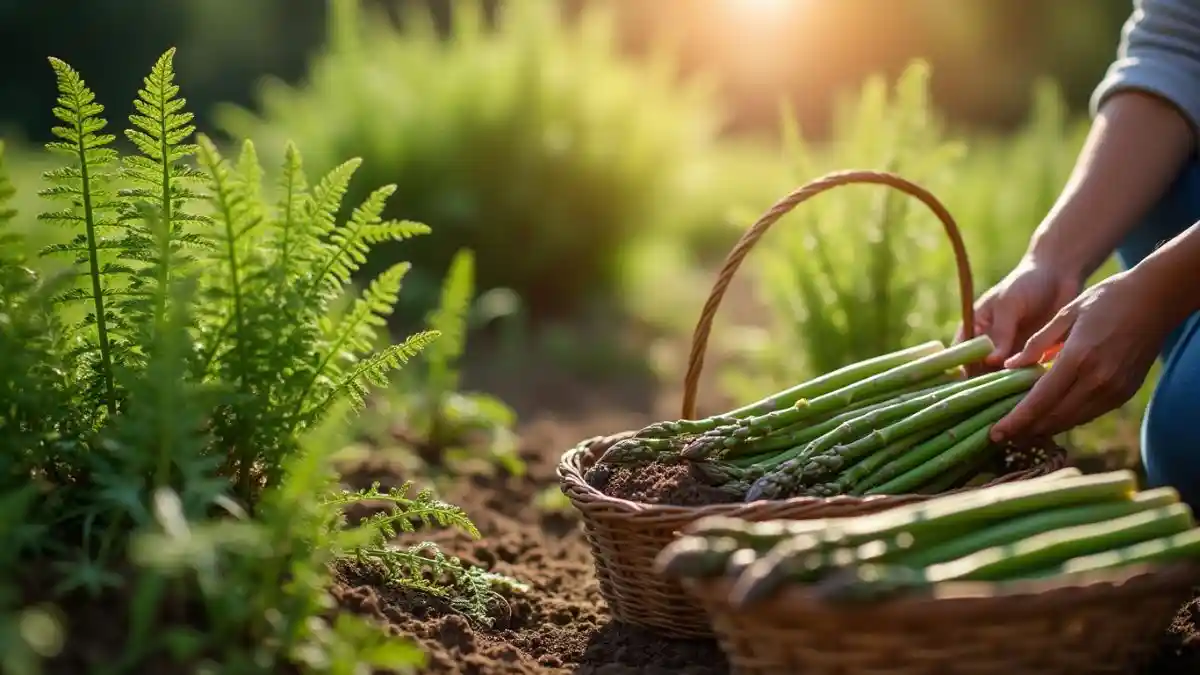
Growing asparagus from seeds requires patience, but the payoff is worth it.
- First 2–3 Years: Avoid harvesting spears to allow plants to establish strong roots.
- Third Year: Harvest spears for 2–4 weeks, then let the ferns grow to replenish energy.
- Fourth Year and Beyond: Enjoy a full harvest season (6–8 weeks) of fresh, homegrown asparagus.
For example, in the third year, you might harvest 5–7 spears per plant, increasing to 10–12 spears in subsequent years.
Tips for Growing Healthy Asparagus
To keep your asparagus plants thriving, follow these tips:
- Weed Regularly: Eliminate weeds to lessen competition for nutrients.
- Monitor for Pests: Watch for asparagus beetles and use organic insecticides if needed.
- Cut Back Ferns: Prune ferns in late fall to avoid overwintering pests.
Common Mistakes to Avoid
Even experienced gardeners can make mistakes when growing asparagus from seeds. Here’s what to watch out for:
- Harvesting Too Early: Avoid harvesting spears in the first 2–3 years to allow plants to establish.
- Overcrowding: Space plants properly to prevent disease and poor growth.
- Ignoring Soil Health: Test and amend your soil regularly to maintain fertility.
How to Save Asparagus Seeds for Future Planting
Saving seeds from your asparagus plants is a great way to ensure a continuous supply.
- Allow Berries to Form: Let some spears grow into ferns and produce red berries.
- Harvest and Dry: Collect berries in late summer, remove seeds, and dry them thoroughly.
- Store Properly: Keep seeds in a cool, dry place in an airtight container for up to 3 years.
Companion Planting for Asparagus
Pairing asparagus with the right plants can boost growth and deter pests.
- Good Companions: Tomatoes, parsley, and basil.
- Avoid: Onions and garlic, which compete for nutrients.
Troubleshooting Common Asparagus Problems
- Yellowing Ferns: Often caused by overwatering or nutrient deficiencies.
- Asparagus Beetles: Handpick beetles or use organic insecticides.
- Fusarium Wilt: Rotate crops and avoid planting in infected soil.
How to Extend Your Asparagus Harvest
- Stagger Planting: Plant early, mid, and late-season varieties.
- Use Row Covers: Protect plants from frost in early spring.
- Mulch Heavily: Regulate soil temperature and moisture.
Conclusion
Growing asparagus from seeds is a rewarding journey that yields delicious, homegrown spears for years to come. By following these 7 easy steps, you can create a thriving asparagus patch that’s both beautiful and sustainable.
Ready to start your asparagus garden? Grab some seeds, prepare your soil, and enjoy the process of growing this incredible vegetable. Share your progress and tips in the comments below—we’d be delighted to hear from you!
FAQ Section
- How long does it take to grow asparagus from seeds?
- It takes 2–3 years before you can harvest spears, but the plants can produce for 15–20 years.
- Can I grow asparagus in containers?
- Yes, but choose deep containers (at least 18 inches) and provide ample space for roots.
- What’s the best soil for growing asparagus?
- Well-draining, fertile soil with a pH of 6.5–7.5 is ideal.
- How do I protect asparagus from pests?
- Use row covers, handpick beetles, and apply organic insecticides if needed.
- Can I grow asparagus in a small garden?
- Yes, but limit the number of plants to ensure they have enough space to thrive.
- What’s the difference between growing asparagus from seeds vs. crowns?
- Seeds are cheaper and offer more variety, but crowns produce harvestable spears faster.
- How do I know when to harvest asparagus?
- Harvest spears when they are 6–8 inches tall and about as thick as your finger.
- Can I grow asparagus in warm climates?
- Yes, but choose heat-tolerant varieties and provide afternoon shade.
- How often should I water asparagus?
- Water thoroughly once a week, keeping the soil moist but not waterlogged.
- What’s the best way to store asparagus seeds?
- Keep seeds in a cool, dry location in an airtight container for up to 3 years.
This comprehensive guide provides everything you need to know about growing asparagus from seeds. By following these tips and recommendations, you’ll be well on your way to cultivating a thriving asparagus garden. Happy gardening!


